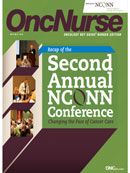Publication
Article
Oncology Nursing News
Net Guides: Melanoma
Author(s):
Useful Online Resources and Clinical Trials for Melanoma
//THE ONLINE Nurse
Melanoma Calculators
These online tools are a part of the Research Projects of the Laboratory for Quantitative Medicine from the Massachusetts General Hospital found on CancerMath.net (part of LifeMath.net). There are 3 Web-based calculators for melanoma: an outcome calculator, a conditional outcome calculator, and a nodal status calculator. The nodal status calculator uses patient information such as age, tumor thickness, Clark level, ulceration, histology, and tumor location to calculate the probability of positive nodes in a patient. The outcome calculator requires the age and gender of the patient as factors of noncancer lethality, as well as tumor thickness, number of positive nodes, nodal mass, Clark level, ulceration, histology, tumor location, location of distant metastasis (if any), and whether serum lactate dehydrogenase (LDH) levels are normal or elevated. The calculator will then display the patient’s classification and American Joint Committee on Cancer (AJCC) stage, the cancer mortality rate, the average life expectancy of a person without cancer who is the same age and gender as the patient, and how many years this cancer shortens that life expectancy. The calculator will also display a graph showing the patient’s mortality risk over time from the cancer, from noncancer reasons and overall. This graph can also be viewed as survival curves, a bar graph, a pie chart, or a pictogram. The conditional outcome calculator is similar, except that it takes into account the number of years since diagnosis and does not include number of years by which the patient’s life expectancy has been shortened. These calculators are based on observed outcomes from patients with melanoma from 1987 to 2006.
//THE EDUCATED PATIENT®
Melanoma International Foundation
The Melanoma International Foundation (MIF) is a nonprofit organization dedicated to helping patients with melanoma through education and support. The “Melanoma Info” section of the MIF Website has a number of pages that patients with melanoma may find useful: a melanoma pictoral atlas; melanoma facts; advice for the newly diagnosed; explanations of pathology, biopsy, and sentinel node biopsy; how to find the right doctor; treatment for stages I to III; treatment for stage IV; and a glossary of medical terms associated with melanoma. In the “Resources” section, patients can find information on cancer centers, support sites, educational programs, clinical trials, and more. The MIF Website also features online forums for people affected by melanoma and a memorial section for loved ones lost to the disease.
//eABSTRACT
Clinical correlates of NRAS and BRAF mutations in primary human melanoma
Journal: Clinical Cancer Research
Authors: Ellerhorst JA, Greene VR, Ekmekcioglu S, et al
Purpose: NRAS and BRAF mutations are both common in cutaneous melanomas, though they are rarely found together in the same tumor. The purpose of this study was to test whether cutaneous melanomas with NRAS or BRAF mutations had a more aggressive clinical phenotype than tumors that were wild type at both loci. The study included 223 primary melanomas that were microdissected before having their NRAS and BRAF mutational status determined. The authors then correlated the genotypic findings with factors that have a proven influence on tumor behavior, including age, gender, Breslow depth, Clark level, mitotic rate, ulceration, and AJCC staging.
Results: The study found that Breslow depth and Clark levels varied significantly among the different genotypes, with NRAS mutants demonstrating the deepest levels and
wild-type tumors showing the least depth. Ulceration also varied, with BRAF mutants having the highest rate. Tumors with NRAS mutations were more likely to be found on extremities. Patients with either NRAS or BRAF mutation presented with more advanced AJCC stages and were more likely to have stage III disease at diagnosis than patients with wild-type tumors. There was no difference in overall survival. The authors concluded that melanomas with NRAS or BRAF mutations are associated with features that are known to predict aggressive tumor behavior, and that the impact of these mutations is most evident at the earlier stages of disease progression.
//CLINICAL TRIALs
Carboplatin, paclitaxel, and temozolomide for patients with metastatic melanoma
Study Type: Interventional
Age/Sex Requirements: 18 years (None)
Sponsor: New Mexico Cancer Care Alliance
ClinicalTrials.gov Identifier: NCT01009515
Purpose: This clinical trial will be testing the combination of carboplatin, paclitaxel, and temozolomide in the treatment of metastatic or recurrent melanoma. The primary outcome measure of the study will be the objective response rate for this combination of drugs in this setting. Secondary outcome measures include the median overall survival and median time to progression, as well as the safety profile and major adverse events for this combination.
Imatinib in patients with mucosal or acral/lentiginous melanoma (BUS255)
Study/Type: Interventional
Age/Sex Requirements: 18 years (None)
Sponsor: Dana-Farber Cancer Institute
Purpose: Imatinib (Gleevec) is a tyrosine kinase inhibitor that obstructs protein signals that lead to cancer cell growth. This phase II, interventional, nonrandomized, open-label, single-group assignment study is examining the efficacy of imatinib in treating acral lentiginous and mucosal melanoma that has spread to other parts of the body in patients with c-kit mutations. The primary outcome measures of this clinical trial are response rate and time to progression. Secondary outcome measures for the study are to correlate c-kit mutational status with response to therapy and to evaluate the tolerability of imatinib in the patient population. Study participants will receive a bottle of 100 mg imatinib pills and will be directed to take 4 pills once daily. If a patient’s condition worsens, the dose may be increased to 400 mg twice daily. The treatment will last approximately 1 year.










